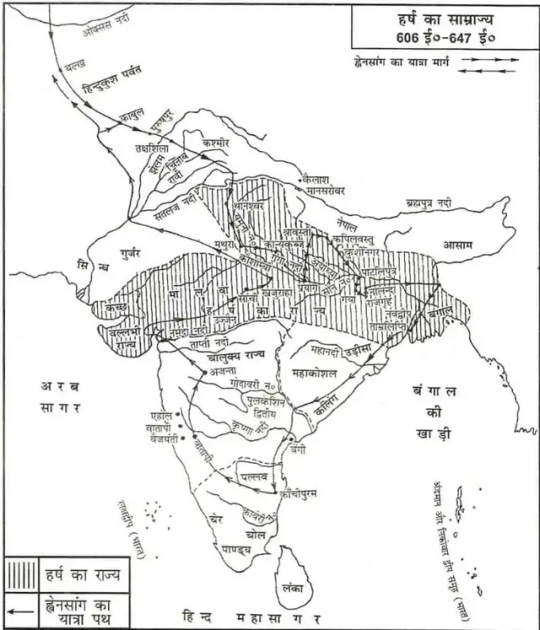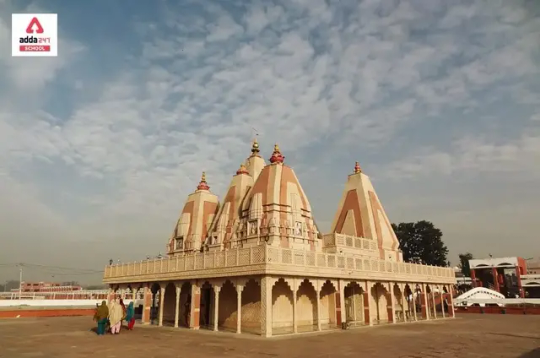#Pushyabhuti Dynasty
Text
Harshavardhana Dynasty also called the Pushyabhuti dynasty
Harshavardhana Dynasty also called the Pushyabhuti dynasty
Harshavardhana (590-647 AD) Was The Great Ruler Of This Dynasty. He Transferred His Radhani From Thaneshwar To Kannauj.
Harshavardhana Dynasty also called the Pushyabhuti dynasty
Pushyabhuti Dynasty Was Established In Thaneshwar. The First Important Ruler Of This Dynasty Was Prabhakarvardhana.
Banabhatta Was Harsha’s Court Poet. He…

View On WordPress
#Harsha#harshavardhana#harshavardhana empire#King Harshavardhana#Prabhakarvardhana#Pushyabhuti Dynasty#vardhana empire
0 notes
Photo

Pushyabhuti Dynasty
The Pushyabhuti Dynasty (c. 500 CE - 647 CE) rose after the downfall of the Gupta Empire (3rd century CE - 6th century CE) in the 6th century CE in northern India. Also known as the Vardhana or Pushpabhuti Dynasty, the core area of their kingdom was situated in what is now the state of Haryana in India with the capital at Sthanishvara or Thaneshvara (present-day Thanesar), and later at Kanyakubja (modern-day Kannauj, Uttar Pradesh state). The most notable ruler of this dynasty was its last ruler, Emperor Harshavardhana or Harsha (r. 606-647 CE). The Pushyabhutis established a powerful kingdom vying with other regional powers for political supremacy in India and, under Harsha, achieved imperial status. However, it was short-lived, and Kannauj came to be known ultimately as the base kingdom for future empires.
Continue reading...
65 notes
·
View notes
Text
Haryana was part of the Kuru Kingdom during the Vedic era during 1200 BCE.
Haryana has been inhabited since the pre-historic period. Haryana was part of the Indus Valley civilization during the Bronze Age period. The ancient sites of Rakhigarhi and Bhirrana are some of the oldest Indus Valley civilization sites.(5) Haryana was part of the Kuru Kingdom during the Vedic era during 1200 BCE.(6)(7)(8) The area now Haryana has been ruled by some of the major empires of India. The Pushyabhuti dynasty ruled the region in the 7th century, with its capital at Thanesar. Harsha was a prominent king of the dynasty.(9) The Tomara dynasty ruled the region from 8th to 12th century. The Chahamanas of Shakambhari defeated them in the 12th century.(10)
Harsha Ka Tila mound, ruins from the reign of 7th century ruler Harsha.
Lal kot built by Anangpal Tomar in 1052
Portrait of Hem Chandra Vikramaditya, who fought and won across North India from the Punjab to Bengal, winning 22 straight battles.(11)
In 1192, Chahamanas were defeated by Ghurids in Second Battle of Tarain.(10) In 1398, Timur attacked and sacked the cities of Sirsa, Fatehabad, Sunam, Kaithal and Panipat.(12)(13) In the First Battle of Panipat (1526), Babur defeated the Lodis. Hem Chandra Vikramaditya claimed royal status after defeating Akbar's Mughal forces on 7 October 1556 in the Battle of Delhi. In the Second Battle of Panipat (1556), Akbar defeated the local Haryanvi Hindu Emperor of Delhi, who belonged to Rewari. Hem Chandra Vikramaditya had won 22 battles across India from Punjab to Bengal, defeating the Mughals and Afghans. Hemu had defeated Akbar's forces twice at Agra and the Battle of Delhi in 1556 to become the last Hindu Emperor of India with a formal coronation at Purana Quila in Delhi on 7 October 1556. In the Third Battle of Panipat (1761), the Afghan king Ahmad Shah Abdali defeated the Marathas.(14)
In 1966, the Punjab Reorganisation Act (1966) came into effect, resulting in the creation of the state of Haryana on 1 November 1966.(15)
Distribution
Haryanvis within Haryana
See also: Demography of Haryana
The main communities in Haryana are Gujjar, Jat, Brahmin, Agarwal, Ahir, Chamar, Nai, Ror,Rajput, Saini, Kumhar, Bishnoi etc.(16) Punjabi khatri and Sindhi refugees who migrated from Pakistan had settled in large numbers in Haryana and delhi.
Haryanvi diaspora overseas
(icon)
This section needs expansion. You can help by adding to it. (July 2021)
See also: Indian disaspora overseas
There is increasingly large diaspora of Haryanvis in Australia, Canada, Singapore, New Zealand, Saudi Arabia, UAE, UK, USA, etc.
In Australia, the community lives mainly in Sydney and Melbourne, has set up Association of Haryanvis in Australia (AHA) which organise events.(17)
In Singapore, the community has set up the Singapore Haryanvi Kunba organisation in 2012 which also has a Facebook group of same name. Singapore has Arya Samaj and several Hindu temples.
Culture
Main article: Haryanvi culture
Language
Main article: Haryanvi language
Haryanvi, like Khariboli and Braj is a branch of the Western Hindi dialect, and it is written in Devanagari script.(18)
Folk music and dance
Main article: Music of Haryana
Folk music is integral part of Haryanvi culture. Folk song are sung during occasion of child birth, wedding, festival, and Satsang (singing religious songs).(2) Some haryanvi folk songs which are sung by young woman and girls are Phagan, katak, Samman, Jatki, Jachcha, Bande-Bandee, Santhene. Some songs which are sung by older women are Mangal geet, Bhajan, Sagai, bhat, Kuan pujan, Sanjhi and Holi. Folk songs are sung in Tar or Mandra stan.(19) Some dances are Khoriya, Chaupaiya, Loor, Been, Ghoomar, Dhamal, Phaag, Sawan and Gugga.(19)
Cuisine
Haryana is agricultural state known for producing foodgrains such as wheat, barley, pearl millet, maize, rice and high-quality dairy. Daily village meal in Haryana consist of a simple thali of roti, paired with a leafy stir-fry (saag in dishes such as gajar methi or aloo palak), condiments such as chaas, chutney, pickles. Some known Haryanvi dishes are green choliya (green chickpeas), bathua yogurt, bajre ki roti, sangri ki sabzi (beans), kachri ki chutney (wild cucumber) and bajre ki khichdi. Some sweets are panjiri and pinni prepared by unrefined sugar like bura and shakkar and diary. Malpua are popular during festivals.(20)
Clothes
See also: History of clothing in the Indian subcontinent and History of Textile industry in India
Traditional attire for men is turban, shirt, dhoti, jutti and cotton or woollen shawl. Traditional attire for female is typically an orhna (veil), shirt or angia (short blouse), ghagri (heavy long skirt) and Jitti. Saris are also worn. Traditionally the Khaddar (coarse cotton weave cloth) is a frequently used as the fabric.(21)(22)
Cinema
See also: Haryanvi cinema and List of Haryanvi-language films
The First movie of Haryanvi cinema is Dharti which was released in 1968. The first financially successful Haryanvi movie was Chandrawal (1984) which spurted the continuing production of Haryanvi films, although none have been as successful.(23) Other films such as Phool Badan and Chora Haryane Ka followed with only about one out of twelve films being profitable at the box office.(23) In 2000, Aswini Chowdhary won the Indira Gandhi Award for Best Debut Film of a Director at the National Film Awards for the Haryanvi film Laddo.(24) In 2010 the government of Haryana announced they were considering establishing a film board to promote Haryanvi-language films.(25)

2 notes
·
View notes
Text
Vardhan Vansh in Hindi | Pushyabhuti Vansh
Vardhan Vansh in Hindi | Pushyabhuti Vansh
पुष्यभूति वंश या वर्द्धन वंश
छठी शताब्दी ई. का भारत
पुष्यभूति ने हरियाणा के थानेश्वर को राजधानी बनाकर पुष्यभूति या वर्द्धन वंश की स्थापना की।इस वंश के अभिलेखों से शासकों को यह क्रम प्राप्त होता है।
पुष्यभूति वंश के शासक (Pushyabhuti Vansh Ke Shasak)-
पुष्यभूतिनरवर्धनराज्यवर्धनआदित्यवर्धनप्रभाकरवर्धनराज्यवर्धन-IIहर्षवर्धन
प्रभाकरवर्धन-
प्रभाकरवर्धन को हूणों के साथ हुए संधर्ष के कारण…

View On WordPress
#Pushyabhuti Dynasty#Pushyabhuti Vansh#Pushyabhuti Vansh in Hindi#Pushyabhuti Vansh Ka Sansthapak#Pushyabhuti Vansh Ki Sthapna#Vardhan Vansh in Hindi#Vardhan Vansh Ka Itihas#Vardhan Vansh Ka Sansthapak#Vardhan Vansh Ka Sansthapak Kaun Tha#Vardhan Vansh Ki Prashasnik Vyavastha#Vardhan Vansh Ki Sthapna#Vardhana Dynasty
0 notes
Photo

Harsha
L'empereur Harshavardhana, plus connu sous le nom de Harsha, vécut de 590 à 647 et fut le dernier souverain de l'empire Vardhana, le dernier grand empire de l'Inde ancienne avant l'invasion islamique. Il régna de 606 à 647. Après la mort d'Harshavardhana, cependant, la dynastie Vardhana ou Pushyabhuti prit fin et son empire se dissout.
Lire la suite...
1 note
·
View note
Text







Khajuraho
Khajuraho is a town in the Indian state of Madhya Pradesh, located in Chhatarpur District. One of the most popular tourist destinations in India, Khajuraho has the country's largest group of medieval Hindu and Jain temples, famous for their erotic sculptures. The Khajuraho Group of Monuments has been listed as a UNESCO World Heritage Site since 1986 and is considered one of the "seven wonders" of India. The town's name, anciently "Kharjuravahaka", is derived from the Sanskrit word kharjur meaning "date palm".
The region was historically part of many kingdoms and empires. The earliest known power to have had Khajuraho in its territory were the Vatsa. Their successors in the region included the Mauryans, Sungas, Kushans, Nagas of Padmavati, the Vakataka dynasty, the Guptas, the Pushyabhuti dynasty, and the Gurjara-Praithara dynasty. It was specifically during the Gupta period that architecture and art began to flourish in the region although their successors continued the artistic tradition.
History
The Chandelas ruled the area from the 9th century although they were subject to the Gurjara-Praitharas. During the reign of Dhanga (c. 950-1002) the Chandelas became independent and many important temples were built during this time.The Chandelas were dealt with fatal blows first from the Chahamanas of Shakambhari in 1182 then from Qutb al-Din Aibak in 1202. Khajuraho declined to a small village as the Chandelas transferred their activities to the forts of Mahoba, Kalinjar, and Ajayagarh.
Ibn Battuta visited Karjuraho and described the presence of temples and a few ascetics. Some temples were damaged by Sikander Lodi in 1495. By the 16th century Khajuraho became an insignificant place and was only "rediscovered" by C. J. Franklin (a military surveyor) in 1819. However, the actual distinction of bringing Khajuraho back to the world's attention is given to T. S. Burt (a British army captain) who visited it in 1838. The next significant visitor was Alexander Cunningham between 1852 and 1855.
0 notes
Text
Pushyabhuti Dynasty

The Pushyabhuti Dynasty (c. 500 CE – 647 CE) rose after the downfall of the Gupta Empire (3rd century CE – 6th century CE) in the 6th century CE in northern India. Also known as the Vardhana or Pushpabhuti Dynasty, the core area of their kingdom was situated in what is now the state of Haryana in India with the capital at Sthanishvara or Thaneshvara (present-day Thanesar), and later at…
View On WordPress
0 notes